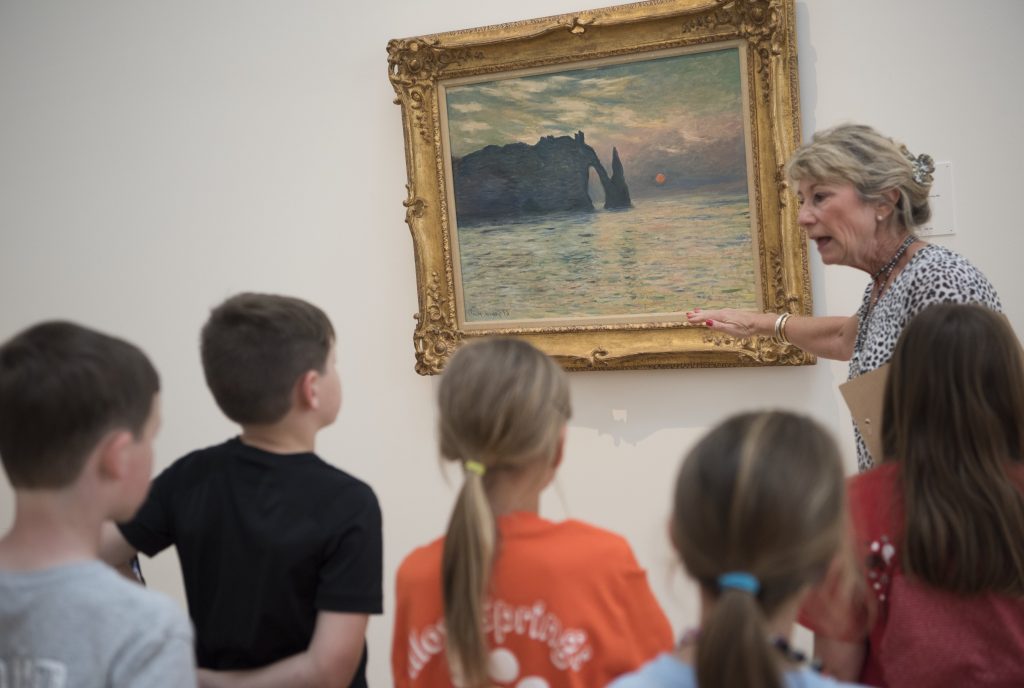Activity Idea: Monet-inspired Poetry (Quick Tip)
Monet-Inspired Poetry
Monet often painted the same scene repeatedly to capture changing seasons and the passing of the day. Etretat in Normandy was no different, and Monet painted numerous scenes, such as The Cliffs at Etretat (1885), The Manneporte (Etretat) (1883), and our own The Cliff, Etretat, Sunset (1883), which offers us a close look at Monet’s attention to the progression of daylight, the movement of the surrounding environment, and use of color.
Like Monet, many poets explore the concept of time through the passing of the day and the seasons; often, these progressions become a metaphor for the progression of life and life’s experiences. To compliment The Cliff, Etretat, Sunset, we have selected six poems that highlight these uses of imagery and metaphor.
- “To the Virgins, to Make Much of Time” by Robert Herrick
- “Yesterday and Today” by Langston Hughes
- “The Human Seasons” by John Keats
- “Sonnet 73” by William Shakespeare
- “Do not go gentle into that good night” by Dylan Thomas
- “A Hymn to the Evening” by Phillis Wheatley
At Home
Are you interested in capturing your ideas about The Cliff, Etretat, Sunset, the changing seasons, the passing of time, ageing, or the relationship between nature and life? We recommend trying your hand at the villanelle, a type of lyrical poem that relies heavily on repetition and is demonstrated above in “Do not go gentle into that good night.” Share your poems on social media and tag #ncartmuseum.
The villanelle is composed of five tercets (three lines) and a final quatrain (four lines). Its singular feature is the way its first and third lines repeat throughout the poem; for example, in “Do not go gentle into that good night,” the first line reappears as the last line of the second and fourth tercets, and the third line reappears as the final line in the third and fifth tercets and as the concluding line of the poem.
For Middle and High-School Teachers
Reading Poetry Actively
Active reading is what you actually do when you read and reread a poem, and annotating, or marking up, a poem while you’re reading will help you record observations, make connections, and determine meaning. Here are a few tips:
- Read the poem to yourself silently.
- Read the poem to yourself aloud.
- Circle any words that stand out to you. These may be words you don’t know or words that engender an emotional response or connection in you.
- On the left side of the poem, write down what is happening in the poem or its narrative content. (Remember that a poet and a poem’s speaker are different.)
- Observe the poem’s structure: How many stanzas are there? Is there a rhyming pattern? Is there a shift in content that parallels structure?
- Underline uses of literary devices you recognize; these may include tone, mood, diction, symbolism, imagery, metaphor, irony…
- On the right side of the poem, write down your interpretations about the how or the literary devices you have underlined.
- Record your ideas about the title and its relationship to the what and the how.
- Record your ideas about the speaker and the speaker’s relationship to the what and the how.
- Remember that in poetry, what + how = why. Write down why you think the poet wrote this poem.
Questions for Reflection
- What feelings emerged when you read this poem?
- What words, phrases, and details engendered your strongest responses?
- What associations about your own life or the lives of friends and family members do you bring to the poem?
- What connections can you make between the action of the poem and the language and literary devices of imagery and metaphor?
- What inferences can you draw from these connections?
- What theme or message does the poem deliver?

